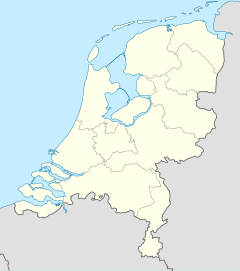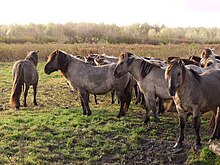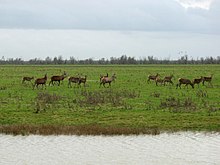Oostvaardersplassen
| Oostvaardersplassen nature development area | ||
|---|---|---|
|
|
||
| Location: | Flevoland , Netherlands | |
| Next city: | Almere | |
| Surface: | 56 km² | |
| Founding: | 1968 | |
| Typical polder landscape in Oostvaardersplassen | ||
The Oostvaardersplassen nature development area is located on the north-western edge of the Flevoland province between Lelystad and Almere , not far from Amsterdam in the Netherlands .
development
After the southern IJsselmeer - today's province of Flevoland - was drained in 1968, it was found that the deepest part of the polder did not fall completely dry. The area was originally intended for the settlement of oil and heavy industries . After further drainage caused bigger problems than expected and due to the global oil crisis , it was decided in 1972 to give up industrial use. Since agriculture had no need for additional areas that were difficult to cultivate, the area was left fallow . Within a very short time, a natural development then took place at an extent and speed that not even experts would have expected.
The largest lowland reed moor area in Central Europe with a large number of breeding, migrating, dormant and wintering bird species was created on the artificially created land . In 1986 the Dutch government declared the area a State Natural Monument . As early as 1989 it was included in the list of internationally significant wetlands according to the Ramsar Convention .
Over the years, the area began to become overgrown as a result of natural succession . Only a few areas that were intensively grazed by gray geese remained open. In order to support this process, it was decided, in line with the mega herbivore hypothesis, to colonize large herbivores in order to keep the areas permanently open without human intervention. According to this theory, there were not only dense primeval forests in early Europe , as previously assumed, but also large open land areas , especially in the sandy flatlands , which can be traced back to the browsing by large herds of grazing animals such as bison , wild horses or aurochs . In 1992 the release of red deer started , followed by Konik horses and Heck cattle .
So far, the development has proceeded according to the theory, so that the majority of the area today consists of forest-free open land biotopes of moist and dry locations. This has favored the natural settlement of other birds enormously.
When the Council of Europe awarded the European Diploma for Protected Areas in 1999 , Oostvaardersplassen was placed on an equal footing with the most important European wetlands such as the Camargue or the Coto de Doñana . The observed development and the size of the area made it a model case for the emergence of secondary wilderness development areas . In the Netherlands they are referred to as " natural development areas ".
Since 2014, the province of Flevoland has been planning to rededicate the area as the 21st national park in the Netherlands . In 2018, the 28,900 hectare “ Nieuw Land ” national park was established , of which Oostvaardersplassen makes up the largest part.
Natural wealth
Oostvaardersplassen is currently around 5600 ha in size and comprises two thirds of humid and one third of dry habitats .
In contrast to most of the open land biotopes of the Central European cultural landscapes , which require permanent maintenance, the area is rather poor in species with regard to around 250 plant species. The structural wealth, on the other hand, is very large and suggests that biodiversity will also increase in the future .
Not least because of the enormous abundance of fish in the waters with a total of 17 species, around 250 species of birds have so far been counted, 90 of which regularly breed in the area. Among them are especially geese , ducks , Coot , Stelz- and wading birds , seven species of herons , as well as many birds of prey . Highlights include white-tailed eagles (since 2005), ospreys , great white and purple herons , spoonbills and bluethroat . The breeding occurrences of 25 species are important for international species protection .
The naturalized red deer , Koniks and Heck cattle , which come from different populations in Europe to have the largest possible gene pool , now comprise a total of around 2200 animals (850 deer, 1000 horses, 400 Heck cattle), and the trend is rising. Since all three species use different plants, the animals complement each other perfectly. As a replacement for the original European wild horse and the aurochs , both of which have been exterminated for several centuries , Koniks and Heck cattle were chosen to ecologically replace these wild forms.
The carcasses of dead herbivores that are not removed also offer new opportunities to rare animal species. The now native sea eagles benefit from the carrion and in the spring of 2005 a black vulture settled down until it was hit by a migration on August 15 and died.
Considerations to also settle wolves , which would be necessary in order to regulate the number of herbivores naturally, have so far been rejected, since one fears above all the opposition of hunters and cattle herders. In the longer term, however, those responsible expect wolves to migrate from other areas of Central Europe sooner or later. Currently, only marten-like predators and numerous foxes are the largest predators in the area.
maintenance
In order to influence the natural development as little as possible, only two maintenance measures are carried out: on the one hand, the shooting of sick and severely weakened grazing animals as a replacement for the missing predators and on the other hand the option to regulate the water level by means of a pumping station if extreme water levels would occur. Animals that are so weakened or injured that they cannot recover without help are shot by park rangers to save them unnecessary suffering. Otherwise no interventions will be carried out.
criticism
In recent years, and especially in winter 2009/2010, there has been increasing criticism of the care measures. In winter animals starve and sometimes starve to death. In the Dutch parliament, severe winter conditions in Oostvaardersplassen were discussed several times. On March 17, 2010, Parliament submitted a motion to the Agriculture Minister to feed the starving animals. Animal rights activists also complain about the high number of animals in relation to the area as a result of the lack of regulation by natural enemies or hunting .
Future development
A gradual expansion of the area was planned for the future. The chances seemed good, as the area is relatively sparsely populated and more and more arable land is being given up as unprofitable . In the medium term, an approximately 11 km long and 1.5 km wide corridor ( Oostvaarderswold ) of 1800 ha was to be created, which would give the animals access to the Holsterwald forest to the south. A protected area of 15,000 hectares called Oostvaardersland was to be created by 2015. These plans have been put aside for political and financial reasons.
According to the ideas of the conservationists, a network of naturally grazed open land biotopes from Oostvaardersplassen to the Veluwe national parks should be created over the next few decades . In the long term, there was even speculation about an expansion of the area via so-called stepping stone wilderness corridors to the Lower Rhine region and the Lippe .
tourism
Most of the Oostvaardersplassen are not allowed to be entered. This not only serves the animals' need for rest, but also protects visitors from possible animal attacks. However, there are some bird watchers' vantage points and smaller hiking routes in the outskirts, the longest of which is around 5 km through the terrain. In addition, the State Forestry Administration (Staatsbosbeheer), which is also responsible for the management of the nature reserves, regularly offers various guided tours in the visitor center near Lelystad . All information can be found on the website below.
See also
- Dedomestication
- Natural development area (NL)
- Wilderness (especially wilderness development areas )
literature
- Staatsbosbeheer in cooperation with Corporate Plaza (Ed.): Leve de Oostvaardersplassen! Staatsbosbeheer regio Flevoland - Overijssel, Arnhem 2002, ISBN 90-805009-4-1 .
Documentaries
- Mark Verkek: The new wilderness . EMS Films, The Netherlands, 2013 ( assessment by FBW ). German premiere on April 8, 2015 in the Lichtburg in Essen .
- Netherlands: Famine in Paradise , a 7-minute documentary as part of the ARD Weltspiegel from September 9, 2018
Web links
- Website of the Staatsbosbeheer for the Oostvaardersplassen (Dutch)
- Oostvaardersplassen - nature made by human hands. A travel report
- Serengeti behind the dykes - Spiegel online
- From paradise to hell - game and dog
- Bird calendar Oostvaardersplassen (English)
- Oostvaardersland on largeherbivore.org (Engl.)
- Oostvaardersworld (Dutch)
- Black vulture in Oostvaardersplassen (nl. And English)
- Oostvaardersplassen: Original nature or unsuccessful nature park? (Dutch)
Individual evidence
- ↑ National Park Oostvaardersplassen . In: stateninformatie.flevoland.nl, Lelystad, September 2015, accessed on December 8, 2018.
- ^ National Park Nieuw Land . In: nationaalparknieuwland.nl, accessed on December 21, 2018.
- ↑ Emma Marris: Conservation biology: Reflecting the past. In: Nature. 462, 2009, pp. 30-32, doi : 10.1038 / 462030a .
- ↑ www.dierenbescherming.nl nieuws 19-1-2010
- ↑ Handelingen Tweede Kamer 28-1-2010
- ↑ Handelingen Tweede Kamer 17-3-2010
- ↑ Image wars on Wildexperiments.com (English) ( Memento of the original from December 19, 2013 in the Internet Archive ) Info: The archive link was inserted automatically and has not yet been checked. Please check the original and archive link according to the instructions and then remove this notice.
- ^ Status of OostvaardersWold . Provincie Flevoland. Archived from the original on November 5, 2013. Info: The archive link was automatically inserted and not yet checked. Please check the original and archive link according to the instructions and then remove this notice. Retrieved August 20, 2013.
- ↑ Netherlands: Hungersnot im Paradies , ARD-Mediathek, accessed September 15, 2018








